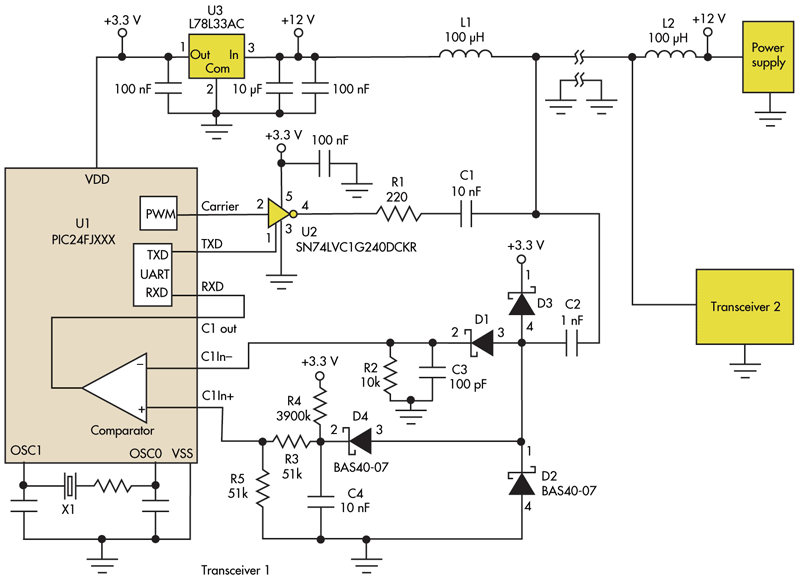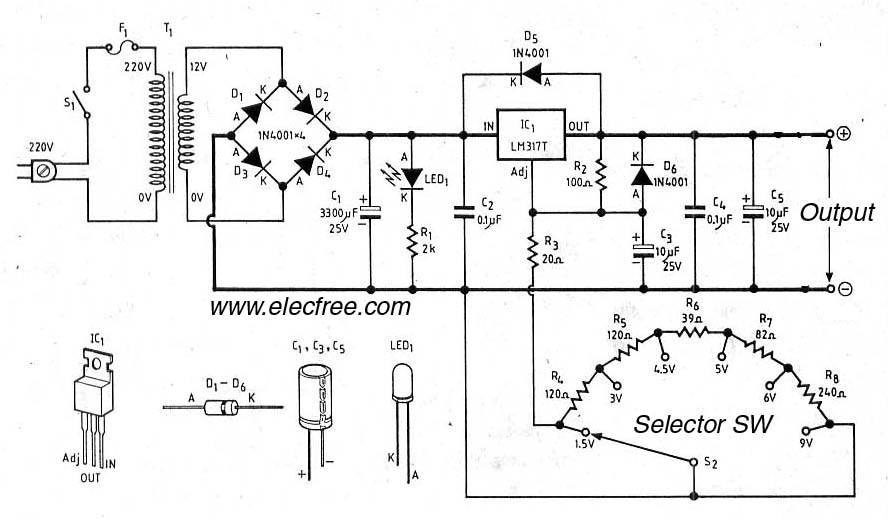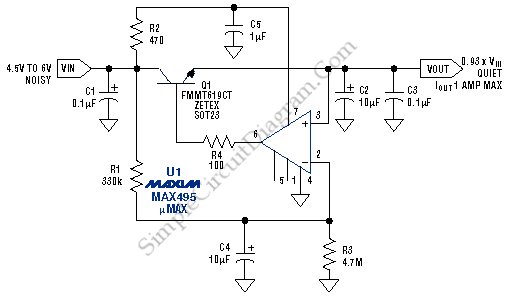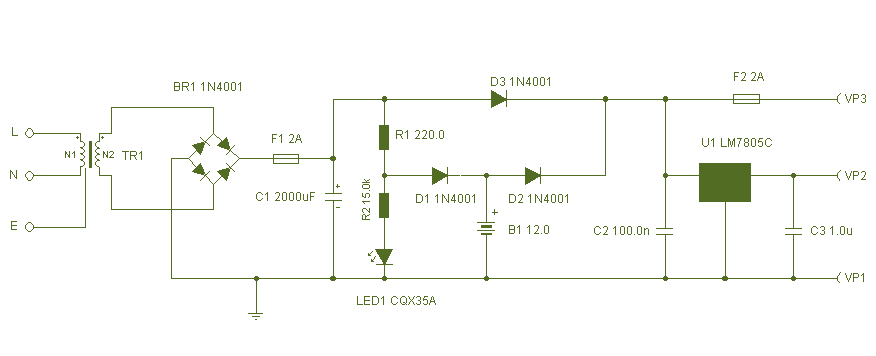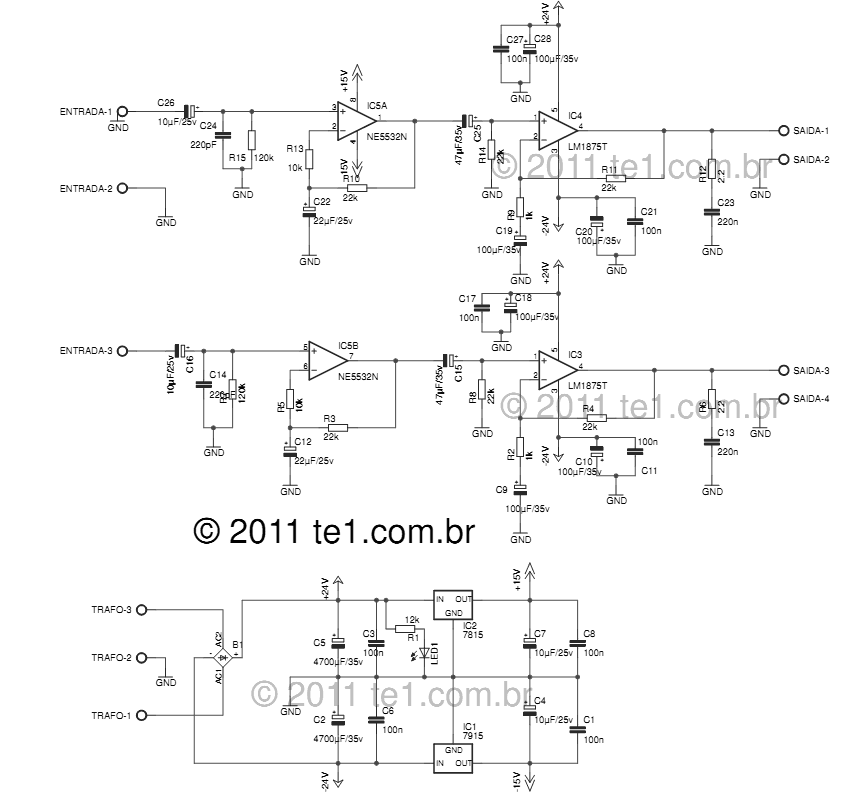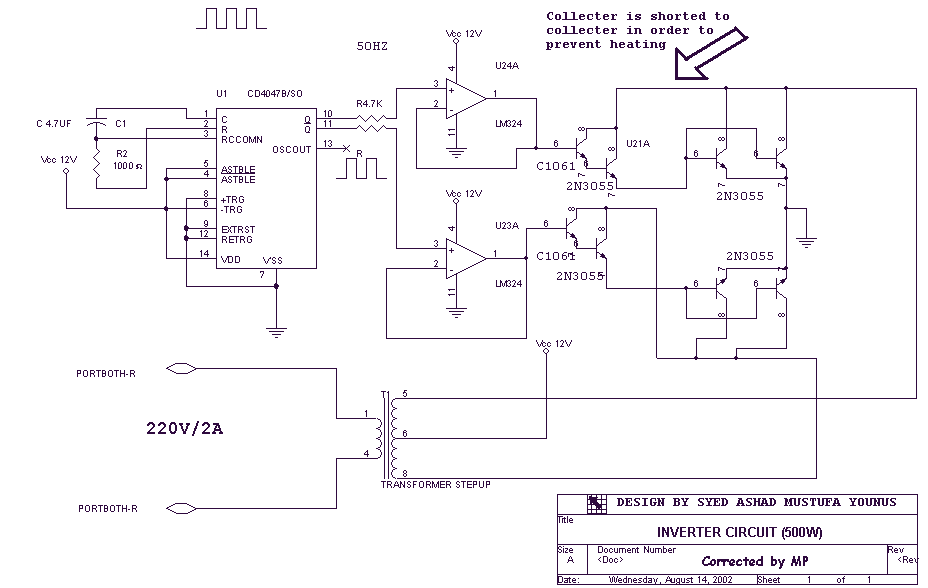
adjustable current limit for dual power
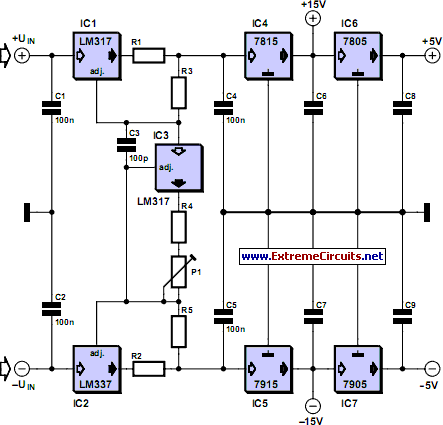
This current-limiting circuit, illustrated as part of a small bench power supply, can be utilized with any dual-rail current source. The section of the circuit on the left limits the current entering the dual voltage regulator (IC4 to IC7) to protect it against overload. The circuit produces outputs at ±15 V and ±5 V. The voltage regulators (7815/7805 and 7915/7905) do not require additional explanation; however, the current-limiting circuit, constructed around an LM317 and an LM337, warrants further clarification. The upper LM317 (IC1) is responsible for the current limiting function in the upper branch. The unique aspect is the combination of two resistors, R1 and R3, connected between the output and the adjust input of the regulator. In a standard LM317 configuration operating in current-limiting mode (as a constant current source), a single resistor is used, across which the regulator maintains a constant voltage of 1.25 V. This results in a current limit of 1.25 V/R. For instance, to achieve a maximum current of 1 A, the required resistor value is 1.25 R. However, constructing an adjustable dual-rail current-limited supply in this manner is impractical, as stereo potentiometers with a value of 1.2 R are extremely rare. This challenge can be addressed by dividing the resistor into two parts. Only the resistor at the output of the LM317 (R1) is used for current sensing, while the second resistor (R3) introduces an additional voltage drop based on an adjustable current. When the sum of the two voltage drops reaches 1.25 V, current limiting is activated. This allows for smooth adjustment of the current limit using the current through the second resistor (R3), which can be simultaneously adjusted in both the positive and negative branches of the circuit. To avoid excessive current through the second resistor, its value is made significantly higher than that of the main resistor. For example, if the main resistor (R1) is set to 1.2 R (yielding a maximum current of 1 A), the second resistor (R3) is set to 120 R, allowing for the necessary voltage drop with an additional current of 10 mA, maintaining the current limit at 1 A. The negative branch of the circuit operates similarly, with the LM337, along with resistors R2 (1.2 R) and R5 (120 R), performing the same functions. An additional LM317 (IC3) is utilized to set the overall current limit by controlling the extra current. The resistance associated with this voltage regulator, configured as a current sink (R4 in series with P1), determines the additional current and consequently the output current in both branches. To achieve a total resistance of R4 and P1 at 120 R, values of 22 R for R4 and 100 R for P1 are selected to provide a wide adjustment range for the output current, from several milliamps to 1 A. The minimum input voltage for the circuit is contingent upon the desired output voltage and maximum output current. The input to the 7815 must be at least 18 V, allowing for approximately 1.2 V + 2.2 V for voltage drops across IC1 and R1. By permitting a total of 4 V for the current limiting circuit in each branch, the entire circuit should be supplied with at least ±22 V to achieve well-regulated outputs at ±15 V and ±5 V. If a symmetrical input voltage is supplied using a single transformer winding, two diodes, and two smoothing capacitors, it is crucial to ensure that the capacitor values are sufficiently large, as the ripple will be significantly greater than with full-wave rectification. Depending on the application, capacitors C6 to C9 at the outputs of the fixed voltage regulators should be appropriately sized to accommodate this increased ripple.
This current-limiting circuit serves as a vital component in ensuring the safe operation of dual-rail power supplies by preventing overload conditions. The design is based on widely used voltage regulator ICs, specifically the LM317 and LM337, which are known for their reliability and ease of integration into various applications. The use of resistors R1 and R3 allows for fine-tuning of the current limit, enabling the user to adjust the output current to meet specific requirements without risking damage to the power supply or connected loads.
In practical applications, the circuit can be employed in laboratory power supplies, test equipment, or any scenario where precise voltage and current control is necessary. The dual-rail configuration is particularly advantageous for powering operational amplifiers and other analog devices that require both positive and negative supply voltages. The careful selection of resistor values ensures that the circuit remains efficient while providing the necessary flexibility for current adjustments.
For optimal performance, attention must be paid to the input voltage levels and the selection of smoothing capacitors. The ripple voltage must be minimized to ensure stable output, especially in sensitive applications. The design's versatility and robustness make it a valuable addition to any electronics engineer's toolkit, capable of handling a range of output requirements while maintaining safe operating conditions.This current-limiting circuit, shown in this example as part of a small bench power supply, could in principle be used in conjunction with any dual-rail current source. The part of the circuit to the left of the diagram limits the current at the input to the dual voltage regulator (IC4 to IC7) so that it is safely protected against overload.
The c ircuit shown produces outputs at ±15 V and ±5V. The voltage regulators at the outputs (7815/7805 and 7915/7905) need no further comment; but the current-limiting circuit itself, built around an LM317 and an LM337, is not quite so self-explanatory. The upper LM317 (IC1) manages the current limiting function for the upper branch of the circuit. The clever part is the combination of the two resistors R1 and R3 between the output and the adjust input of the regulator.
In the basic LM317 configuration in current-limiting mode (i. e. , as a constant current source), just one resistor is used here, across which the regulator maintains a constant voltage of 1. 25 V. The current is thus limited to a value of 1. 25 V/R. To obtain a maximum current of 1 A, for example, the formula tells us that the necessary resistor value is 1.
25R. Unfortunately it is not practical to try to build an adjustable dual-rail current-limited supply in this way, as stereo potentiometers with a value of 1. 2R are extremely difficult, if not impossible, to obtain. We can solve the problem using the technique of dividing the resistor into two resistors. Only the resistor at the output of the LM317 (R1) serves for current sensing. The second resistor (R3) causes an additional voltage drop depending on an additional (and adjustable) current.
When the sum of the two voltages reaches 1. 25 V current limiting cuts in. This makes it possible to adjust the current limit smoothly using the current in the second resistor (R3). This can be done simultaneously in the positive and negative branches of the circuit, as the diagram shows.
It would of course be wasteful to arrange for the current flowing in the second resistor to be of the same order of magnitude as the current in the main resistor. We therefore make the value of the second resistor considerably greater than that of the main one. If the main resistor (R1) has a value of 1. 2R (giving a maximum current of 1 A), and the second resistor (R3) a value of 120R, the necessary voltage drop is achieved using an extra current of 10 ent limit will be 1 A.
For the negative branch of the circuit the LM337, along with resistors R2 (1. 2r) and R5 (120R), performs the same functions. A further LM317 (IC3) is used to set the overall current limit point by controlling the additional current. The resistance used with this voltage regulator, wired as a current sink (R4 in series with P1) determines the additional current and therefore also the output current in both the negative and positive branches of the circuit.
Since we also want the total resistance of R4 and P1 to be 120R, we use a value of 22R for R4 and 100R for P1 to give a wide adjustment range for the output current from a few milliamps to 1A. The minimum input voltage for the circuit depends on the desired output voltage and maximum output current.
The input to the 7815 should be at least 18 V. We should allow approximately a further 1. 2 V + 2. 2 V for the voltage drops across IC1 and R1. If we allow a total of 4V for the current limiting circuit in each branch, this means that the circuit as a whole should be supplied with at least ±22 V to produce well-regulated outputs at ±15 V and ±5V. If the symmetrical input voltage is to be provided using a single transformer winding, two diodes and two smoothing capacitors, it important to ensure that the capacitor values are sufficiently large, as there will be considerably more ripple than there would be with full-wave rectification.
Depending on the application, capacitors C6 to C9 at the outputs of the fixed voltage 🔗 External reference
This current-limiting circuit serves as a vital component in ensuring the safe operation of dual-rail power supplies by preventing overload conditions. The design is based on widely used voltage regulator ICs, specifically the LM317 and LM337, which are known for their reliability and ease of integration into various applications. The use of resistors R1 and R3 allows for fine-tuning of the current limit, enabling the user to adjust the output current to meet specific requirements without risking damage to the power supply or connected loads.
In practical applications, the circuit can be employed in laboratory power supplies, test equipment, or any scenario where precise voltage and current control is necessary. The dual-rail configuration is particularly advantageous for powering operational amplifiers and other analog devices that require both positive and negative supply voltages. The careful selection of resistor values ensures that the circuit remains efficient while providing the necessary flexibility for current adjustments.
For optimal performance, attention must be paid to the input voltage levels and the selection of smoothing capacitors. The ripple voltage must be minimized to ensure stable output, especially in sensitive applications. The design's versatility and robustness make it a valuable addition to any electronics engineer's toolkit, capable of handling a range of output requirements while maintaining safe operating conditions.This current-limiting circuit, shown in this example as part of a small bench power supply, could in principle be used in conjunction with any dual-rail current source. The part of the circuit to the left of the diagram limits the current at the input to the dual voltage regulator (IC4 to IC7) so that it is safely protected against overload.
The c ircuit shown produces outputs at ±15 V and ±5V. The voltage regulators at the outputs (7815/7805 and 7915/7905) need no further comment; but the current-limiting circuit itself, built around an LM317 and an LM337, is not quite so self-explanatory. The upper LM317 (IC1) manages the current limiting function for the upper branch of the circuit. The clever part is the combination of the two resistors R1 and R3 between the output and the adjust input of the regulator.
In the basic LM317 configuration in current-limiting mode (i. e. , as a constant current source), just one resistor is used here, across which the regulator maintains a constant voltage of 1. 25 V. The current is thus limited to a value of 1. 25 V/R. To obtain a maximum current of 1 A, for example, the formula tells us that the necessary resistor value is 1.
25R. Unfortunately it is not practical to try to build an adjustable dual-rail current-limited supply in this way, as stereo potentiometers with a value of 1. 2R are extremely difficult, if not impossible, to obtain. We can solve the problem using the technique of dividing the resistor into two resistors. Only the resistor at the output of the LM317 (R1) serves for current sensing. The second resistor (R3) causes an additional voltage drop depending on an additional (and adjustable) current.
When the sum of the two voltages reaches 1. 25 V current limiting cuts in. This makes it possible to adjust the current limit smoothly using the current in the second resistor (R3). This can be done simultaneously in the positive and negative branches of the circuit, as the diagram shows.
It would of course be wasteful to arrange for the current flowing in the second resistor to be of the same order of magnitude as the current in the main resistor. We therefore make the value of the second resistor considerably greater than that of the main one. If the main resistor (R1) has a value of 1. 2R (giving a maximum current of 1 A), and the second resistor (R3) a value of 120R, the necessary voltage drop is achieved using an extra current of 10 ent limit will be 1 A.
For the negative branch of the circuit the LM337, along with resistors R2 (1. 2r) and R5 (120R), performs the same functions. A further LM317 (IC3) is used to set the overall current limit point by controlling the additional current. The resistance used with this voltage regulator, wired as a current sink (R4 in series with P1) determines the additional current and therefore also the output current in both the negative and positive branches of the circuit.
Since we also want the total resistance of R4 and P1 to be 120R, we use a value of 22R for R4 and 100R for P1 to give a wide adjustment range for the output current from a few milliamps to 1A. The minimum input voltage for the circuit depends on the desired output voltage and maximum output current.
The input to the 7815 should be at least 18 V. We should allow approximately a further 1. 2 V + 2. 2 V for the voltage drops across IC1 and R1. If we allow a total of 4V for the current limiting circuit in each branch, this means that the circuit as a whole should be supplied with at least ±22 V to produce well-regulated outputs at ±15 V and ±5V. If the symmetrical input voltage is to be provided using a single transformer winding, two diodes and two smoothing capacitors, it important to ensure that the capacitor values are sufficiently large, as there will be considerably more ripple than there would be with full-wave rectification.
Depending on the application, capacitors C6 to C9 at the outputs of the fixed voltage 🔗 External reference
